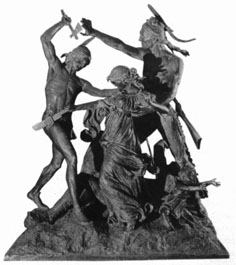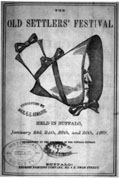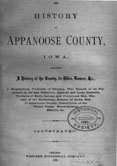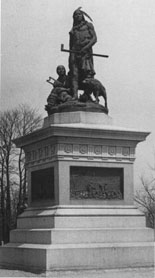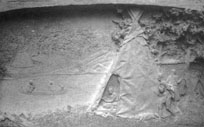<Reprinted
from Chicago
History, Spring 2004>
Symbolic
Native Americans appeared on the Chicago landscape only after the
genuine article had all but faded from Illinois.
During the 1870s and 1880s, when Chicago first began to memorialize
its Indian roots, "old settlers" and "pioneer" associations
emerged across the prosperous farm belt. The preparation of histories
honoring the accomplishments of the pioneers became a major business
for commercial public history companies, such as the Western Historical
Company based in Chicago.
The self-congratulatory
tone most commonly associated with these formalistic volumes
contained a largely nostalgic view
of American Indians. An old settler writing in a 1878 history
of the Grand River Valley remembered that "as friends,
the Indians and settlers lived together with mutual benefit." Later,
when the Indians ceded their lands through a treaty, the settler
claimed, "the Indians, knowing they had sold their rights
cheerfully gave up their cherished homes to the whites." Although
there were occasional attempts to depict the Indian as a savage
enemy, most preferred to believe that the settlers had been
friends with those whom they displaced.
|
|
By the mid-nineteenth century, Americans
had already begun to immortalize the early frontier with
pioneer associations, Old Settlers' Festivals (above,
from 1867), and published local histories (below, from
1878). |
|
|
|
Chicagoans
began to memorialize the area;s Native American roots
with public art. One of the first, "The Alarm" (above,
in 1902), depicted a man with a tomahawk, a dog at his
feet, and an Indian woman cradling her baby. The base of
the monument featured four bronze scenes of Native American
life, including "The Hunt" (below).
Click here for
another view of "The Alarm".
|
|
|
The
Chicago lakefront still boasts a statue that represents,
like those commercial county histories, a
personal if highly nostalgic image of the American Indian.
In 1884, a four figure bronze statuary group was unveiled in
Lincoln Park. John Boyle's creation, "The Alarm",
features a male standing alert, eyes fixed intently ahead,
tomahawk in hand. At his feet, Boyle placed what the Chicago
Tribune called a "wolf like dog, whose shaggy coat
bristles with anger at some approaching danger," while
on the ground behind the man an Indian woman protectively cradles
her baby.
Decorating the base of the monument were four bronze bas relief
depictions of Indian life: "The Hunt", "Forestry", "The Corn
Dance", and "The Peace Pipe". Wealthy lumberman
and fur trader Martin
Ryerson donated the group to the city as a tribute to the friendship
of the Ottawa and Potawatomi whose trade helped his business
grow into one of the largest fortunes in Chicago. A striking
contrast exists between the fate of the Indians depicted in
the group, exiled to a bleak Kansas reservation, and their
young white friend who helped establish high culture in Chicago |
Although "The Alarm" depicts
Ryerson's personal memory of a strong, self sufficient people,
Boyle's figures
bow to the dominant symbols of late nineteenth century America. The
male Indian is not one of the hunters with whom Ryerson worked as
a young businessman, but a warrior armed with a tomahawk. The fierce
dog at his feet embodies savage nature, while the Indian woman and
child, vulnerably exposed on the ground, represent the eventual submission,
if not the demise, of the Native American people.
Forward to the next page of this essay
Back to the previous page Back to Online Essays |

